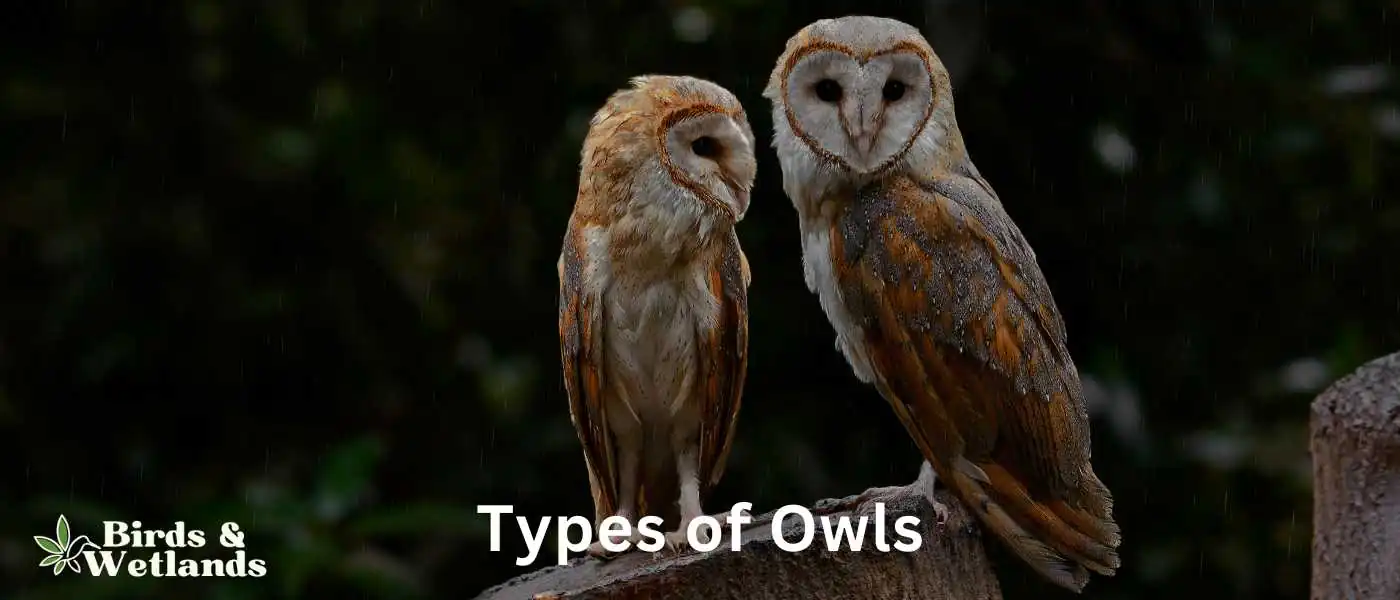Prepare for a night-time adventure as we swoop into the world of these nocturnal marvels. With 19 diverse species to be found across the length and breadth of the United States, owls provide a fascinating insight into the nation’s rich and varied ecosystems. From the adorable Elf Owl, the smallest species, to the imposing Great Horned Owl, there’s an enchanting tale behind each species’ existence.
So, are you ready to immerse yourself in the captivating, often mysterious lives of these night-time predators? Let’s explore the 19 types of owls that call the United States home!
Types of Owls in the United States
| Owl Species | Description | States Found In | Breeding Grounds | Other Notes |
|---|---|---|---|---|
| Great Horned Owl | Large, ear tufted owl with mottled grey-brown plumage. | Throughout the U.S. | Trees, cliffs, buildings, and man-made platforms. | Most widely distributed owl in the Americas. |
| Preferably in man-made structures like barns and silos, but also in tree cavities. | Medium-sized owl with a heart-shaped, white face and pale, golden-brown body. | Throughout the U.S. | Preferentially in man-made structures like barns and silos, but also in tree cavities. | Known for its eerie, raspy call and excellent rodent-hunting abilities. |
| Barred Owl | Medium-sized owl with brown and white striped plumage. | Eastern U.S, Pacific Northwest. | Mature forests near water. | Known for its distinctive “Who cooks for you?” call. |
| Eastern Screech Owl | Small, ear tufted owl with grey or reddish brown plumage. | Eastern U.S. | Tree cavities. | Very adaptable, often found in suburban and urban areas. |
| Western Screech Owl | Small, ear tufted owl with grey or brown plumage. | Western U.S. | Tree cavities. | Closely related to the Eastern Screech Owl. |
| Snowy Owl | Large, white owl. | Northern states, particularly in winter. | Arctic tundra. | Highly nomadic, often moving in response to prey availability. |
| Burrowing Owl | Small, long-legged owl with brown and white mottled plumage. | Western U.S. and Florida. | Ground burrows, often those abandoned by prairie dogs or ground squirrels. | One of the few owls that is active during the day. |
| Northern Saw-whet Owl | Small owl with brown and white plumage. | Northern states and Appalachians. | Mature, dense forests. | Named for its call, which sounds like a saw being sharpened. |
| Great Gray Owl | Large owl with grey plumage and distinctive facial disks. | Northwestern states, particularly in dense forests. | Nests in trees, often using abandoned raptor nests. | Despite its size, it feeds mostly on small mammals. |
| Long Eared Owl | Medium-sized owl with long ear tufts and orange facial disks. | Throughout the U.S., though more common in the West. | Trees, often in dense stands. | Known for its catlike appearance and eerie, mournful calls. |
| Short-eared Owl | Medium-sized owl with short ear tufts and yellow eyes. | Throughout the U.S., though less common in the Southeast. | Ground nests in grasslands or marshes. | One of the most widely distributed owls in the world. |
| Northern Pygmy Owl | Very small owl with brown and white plumage. | Western U.S. | Tree cavities. | Known for its fierce hunting skills, often taking prey larger than itself. |
| Boreal Owl | Small owl with white-spotted grey plumage. | Northern states. | Tree cavities. | Often heard but seldom seen due to its nocturnal habits and remote habitat. |
| Northern Spotted Owl | Medium-sized owl with brown and white spotted plumage. | Pacific Northwest. | Old growth forests. | Considered threatened due to habitat loss. |
| Elf Owl | Very small, greyish-brown owl with no ear tufts. | Southwestern U.S. | Cacti, trees, and buildings. | The world’s lightest owl, weighing less than 2 ounces. |
| Flammulated Owl | Small, grey owl with flame-colored patches. | Western U.S. | Tree cavities in coniferous forests. | A migratory owl, moving south for the winter. |
| Whiskered Screech Owl | Small owl with dark plumage and ear tufts. | Arizona and New Mexico. | Tree cavities. | Despite its name, its call is more of a trill than a screech. |
| Ferruginous Pygmy Owl | Small, reddish-brown owl with no ear tufts. | Southern Texas and Arizona. | Tree cavities, often in woodpecker holes. | Notable for its false eyes on the back of its head. |
| Northern Hawk Owl | Medium-sized owl with a hawk-like appearance. | Northern states. | Trees in open areas. | Named for its hawk-like hunting behavior and long tail. |
| Mexican Spotted Owl | Medium-sized owl with brown and white spotted plumage. | Southwestern U.S. | Rocky canyons and mature forests. | A subspecies of the Spotted Owl, also considered threatened due to habitat loss. |
US Owls Photo Guide
Great Horned Owl (Bubo virginianus)
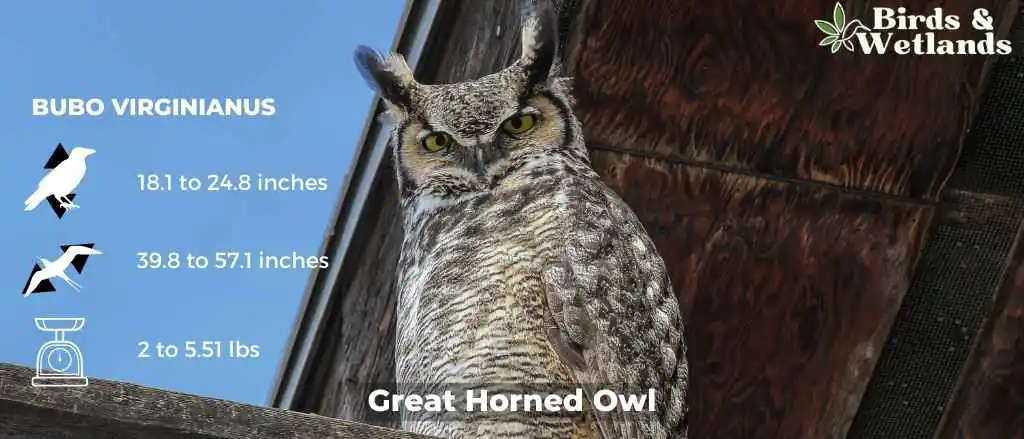

Great Horned Owl Sound
Scientific Name:Bubo virginianus
Length: 18.1-24.8 in
Wingspan: 39.8-57.1 in
Weight: 32.1-88.2 oz
The Great Horned Owl is a large owl with long wings and a large head. It’s one of the most common owls in North America.
Great Horned Owls are large, stocky birds with soft feathers that are gray to brown on their backs and white on their chests. Their faces are characterized by two black “ear” tufts, which can be raised or flattened depending on the owl’s mood. The eyes are yellow, orange, or red in color.
The habitat of the Great Horned Owl is a variety of different environments such as forests and deserts. They also live near water sources such as lakes, streams and rivers where they can hunt for fish.
The diet of the Great Horned Owl consists primarily of small mammals such as mice and rats; however they will also eat other rodents such as squirrels, rabbits and porcupines. They have been known to eat skunks too.
Barn Owl (Tyto alba)

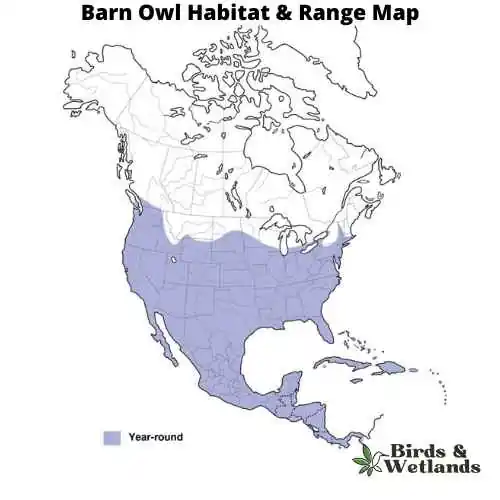
Barn Owl Sound
Scientific Name: Tyto alba
Length: 13 to 15 in
Wingspan: 31 to 37 in
Weight: 9.2 oz
The Barn Owl is a widespread species of owl known for its distinctive heart-shaped facial disc.
Barn Owls are medium-sized owls, they are pale overall with golden-brown wings and back, contrasted by a white face, chest, and belly. Their most notable feature is their heart-shaped facial disc, which helps channel sound to their ears.
Barn Owls are typically found in open habitats, including farmland, woodland, and marshes. They are named for their habit of nesting in human structures such as barns, church towers, and in the hollows of large trees. These owls are nocturnal, hunting at night and roosting during the day.
The diet of Barn Owls primarily consists of small mammals, particularly rodents such as mice and rats. They are known for their silent flight, which allows them to sneak up on their prey without detection.
Barn Owls have a unique nesting behavior. They do not build nests, but instead, lay their eggs directly on the bare surface of a secluded ledge or cavity. A female typically lays 4-7 eggs, and both parents help incubate the eggs and care for the chicks.
Barred Owl (Strix varia)
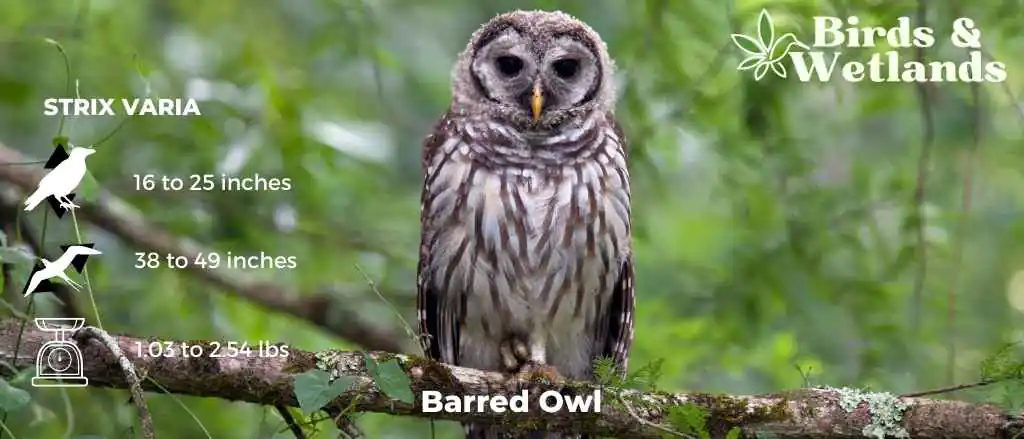

Barred Owl Sound
Scientific Name: Strix varia
Length: 40 to 63 cm (16 to 25 in)
Wingspan: 96 to 125 cm (38 to 49 in)
Weight: 468 to 1,150 g
The Barred Owl is a medium-sized owl with a barred pattern on its chest and belly. They have large yellow eyes that allow them to see well in low light conditions. Their ears are not very large which means they do not hear very well but they have excellent hearing abilities which allow them to detect sounds up to 1 mile away. Their feathers are brown and streaked with white, and they have black bars on their chests and wings.
Their habitats include forests, woodlands, orchards, parks, farmland and suburban backyards.
Barred Owls (also known as hoot owl) eat small mammals such as mice, rats and squirrels. They also eat insects such as beetles or grasshoppers. These owls hunt during the day when it is light out so that they can see their prey better than at night when they would be using senses other than sight like sound or smell to find their food source.
Barred owls are monogamous birds which means they mate for life. They build nests in trees or cavities on the ground and lay 2-4 eggs per year. The incubation period for these eggs lasts about 28 days before hatching takes place.
Eastern Screech-Owl (Megascops asio)
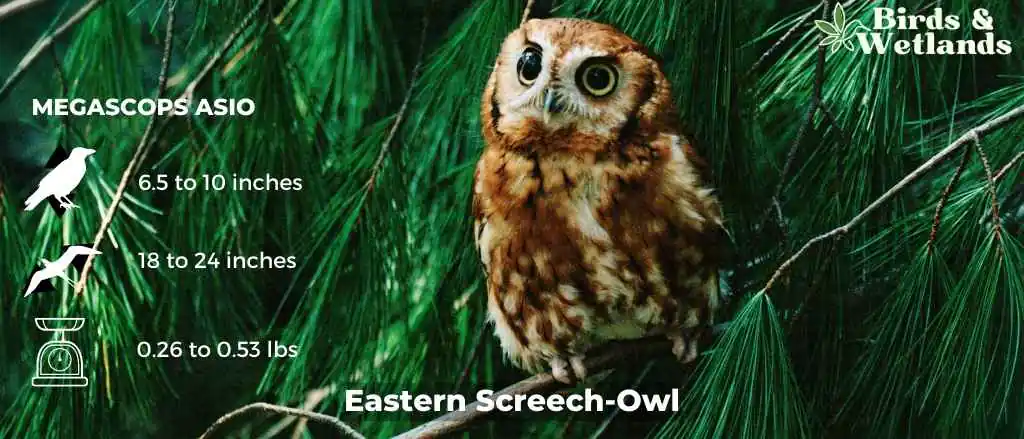
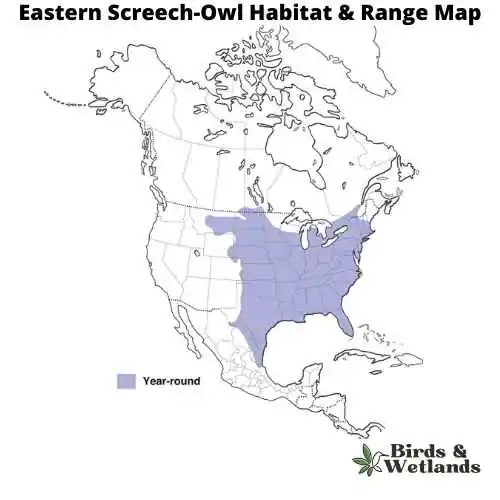
Eastern Screech-Owl Sound
Scientific Name: Megascops asio
Length: 6 to 10 in
Wingspan: 8 to 24 in
Weight: 4 – 8.5 oz
The Eastern Screech-Owl is a small owl species native to most wooded environments of the eastern half of North America, from the Canadian provinces to Florida and Texas.
Eastern Screech-Owls are relatively small and exhibit a complex pattern of gray or reddish-brown coloration, which provides excellent camouflage against tree bark.
These owls are known for their distinctive call, which is often described as a haunting trill or a whinny-like sound. Despite their name, they do not actually produce a “screech.”
Eastern Screech-Owls feed on a variety of prey, ranging from small mammals and birds to insects and even earthworms. It is primarily nocturnal, hunting at night from a low perch and swooping down onto prey.
Eastern Screech-Owls nest in tree cavities or abandoned woodpecker nests, but they readily adapt to nesting boxes where natural cavities are not available. They typically lay between 2 to 6 eggs, which are incubated primarily by the female.
Western Screech-Owl (Western Screech-Owl)
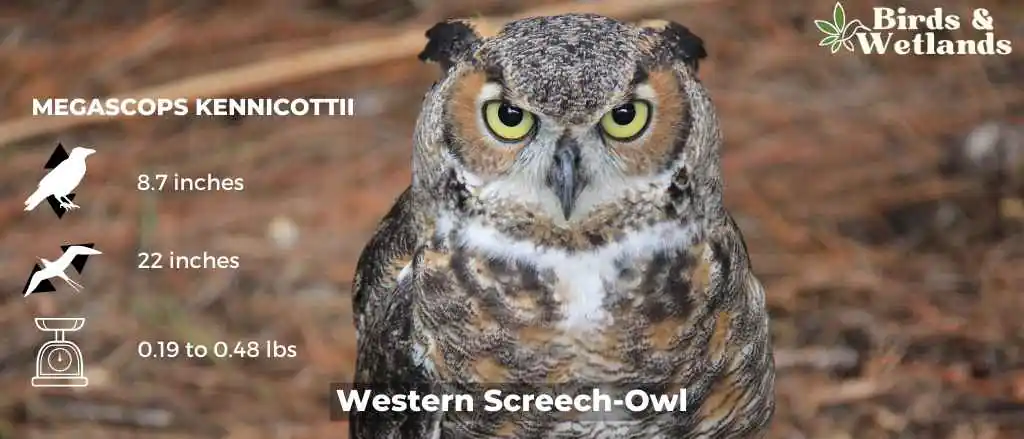
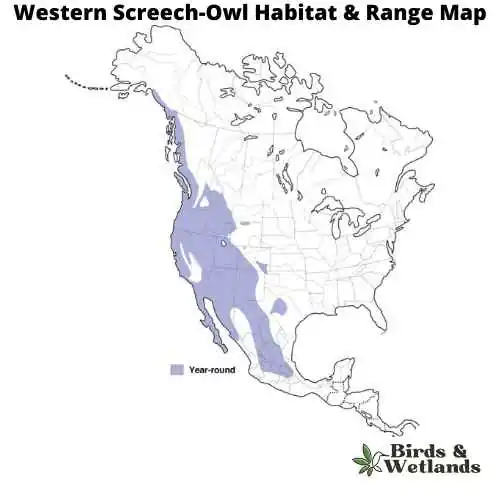
Western Screech-Owl Sound
Scientific Name: Megascops kennicottii
Length: 22 cm (8.7 in)
Wingspan: 55 cm (22 in)n
Weight: 88 to 220 g (3.1 to 7.8 oz)
The Western Screech-Owl, or Megascops kennicottii, is a small species of owl native to North and Central America. Western Screech-Owls are nocturnal predators, and its diet primarily consists of small mammals, birds, insects, and occasionally fish.
This owl is medium-sized compared to other screech-owls. It has a compact, stocky body, and is often recognized by its large head with yellow eyes surrounded by greyish-brown facial disks. The plumage is generally a mixture of grey and brown, with intricate patterns of spots and streaks that provide excellent camouflage against tree bark.
These owls prefer mixed woodland habitats, including deciduous forests and semi-open areas with trees. They often nest in tree cavities, but will also readily take to nest boxes if available. These birds are primarily non-migratory, and once they’ve established a territory, they tend to stay within the same area year-round.
Snowy owl (Bubo scandiacus)

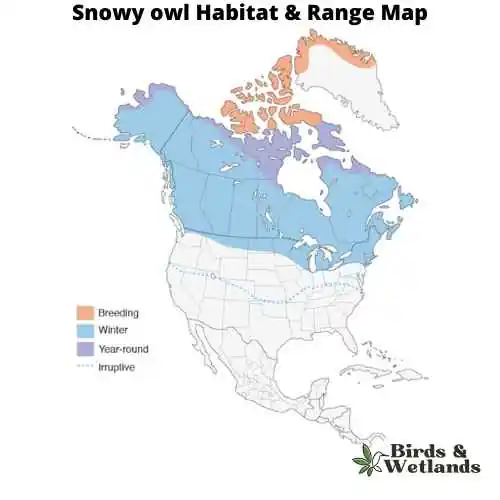
Snowy owl Sound
Scientific Name: Bubo scandiacus
Length: 20.7 to 28 in
Wingspan: 3 ft 10 in to 6 ft 0 in
Weight: 3.2lb to 5.3lb
The Snowy Owl, is of the most well-known species of owls, the Snowy Owl is renowned for its striking appearance and adaptations to its extreme environment.
Snowy Owls are medium sized birds that possess a rounded head, yellow eyes, and a black beak. The most distinctive feature of the Snowy Owl is its white plumage, which provides effective camouflage in its snowy habitat. Male Snowy Owls are often almost completely white, while females and younger owls have more extensive dark barring on their plumage.
Unlike many owl species, Snowy Owls are primarily diurnal, which means they are active during the day. This is an adaptation to life in the Arctic, where there can be 24 hours of daylight in the summer. Their diet mainly consists of small mammals, particularly lemmings, but they are known to eat a variety of animals including birds, fish, and even carrion when necessary.
Snowy Owls nest on the ground, usually on a mound or boulder. Their breeding success is closely tied to the availability of food, and in good years a single pair of owls can raise a large brood of chicks.
Burrowing Owl (Athene cunicularia)
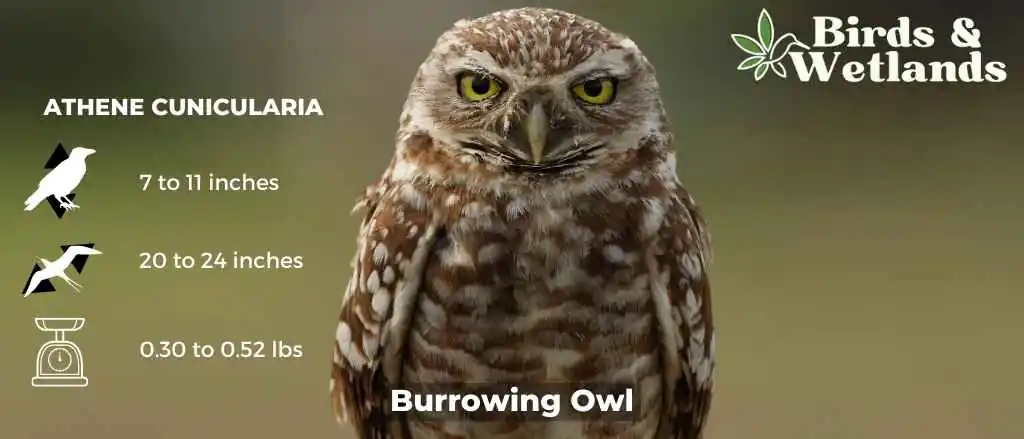

Burrowing Owl Sound
Scientific Name: Athene cunicularia
Length: 7–11 in
Wingspan: 20–24 in
Weight:5–8 oz
The Burrowing Owl is a small, long-legged species of owl found in North and South America. Known for its unusual habit of living in burrows in the ground.
Burrowing Owls have a rounded head with no ear tufts and bright yellow eyes. Their overall coloration is mottled brown and white with a distinct white “eyebrow” above each eye.
Their primary habitat includes open landscapes such as grasslands, deserts, agricultural areas, golf courses, and even airports. As their name suggests, these owls often reside in burrows, many of which are abandoned by prairie dogs, ground squirrels, or other burrowing animals. In some cases, they may also dig their own burrows.
Burrowing Owls diet consists mainly of small mammals and insects, but they also eat birds and reptiles.
Burrowing Owls have a unique nesting behavior. They lay their eggs in an underground burrow to protect them from predators and extreme weather. Clutch sizes range from 6 to 11 eggs, which are incubated for about a month before hatching.
Northern Saw-whet Owl (Aegolius acadicus)
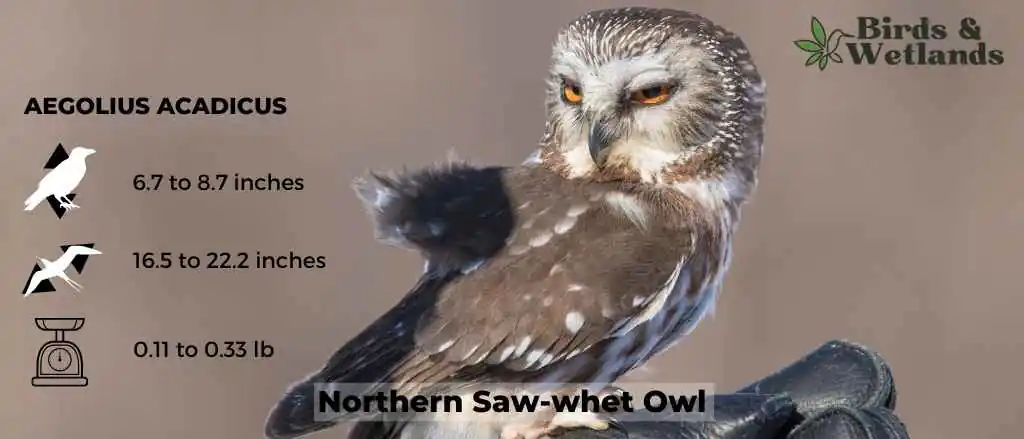

Northern Saw-whet Owl Sound
Scientific Name: Aegolius acadicus
Length: 17–22 cm (6.7–8.7 in)
Wingspan: 42–56.3 cm (16.5–22.2 in)
Weight: 54 to 151 g (1.9 to 5.3 oz)
The Northern Saw-whet Owl is a tiny, speckled gray owl and it’s one of the smallest owls in North America. It’s also known as the Little Owl or Wood Owl in some areas.
Northern Saw-whet Owls have dark brown eyes, white eyebrows, and yellow beak. It has brownish-grey feathers that are spotted with white. The owl’s legs are covered in feathers and appear nearly invisible when the bird is perched on a branch or tree.
In the winter they migrate south to warmer climates. They prefer to live in dense coniferous forest with large trees but will occasionally nest in shrubs or other vegetation that can protect them from predators.
The Northern Saw-whet Owl eats mice and voles (small rodents), small birds, frogs, salamanders, moles and shrews, but unlike most owls they chop their prey up and spread over a few meals. They will also eat insects like beetles and grasshoppers if they are available. It hunts from a perch at night using its excellent hearing to locate prey items within about 30 feet (9 meters) of its nest.
These owls nest in tree cavities usually located close to water sources such as lakes or rivers where they can find their food source (insects). They lay 2-4 eggs at one time which incubate for about 30 days before hatching.
Great Gray Owl (Strix nebulosa)


Great Gray Owl Sound
Scientific Name: Strix nebulosa
Length: 26 in to 28 in
Wingspan: 56 to 60 in
Weight:2.2 lb to 2.85lb
The Great Gray Owl, or Strix nebulosa, is a very large owl, native to the boreal forests across North America and Eurasia. Despite its great size, it’s more so known for its impressive appearance rather than its weight, as it is outweighed by several other large owl species.
The Great Gray Owl has a large, rounded head with a grey face and yellow eyes, surrounded by concentric circles of dark and light feathering. It is known for its bow-tie-shaped white moustache stripe and black chin spot.
One of the distinguishing characteristics of this owl is its elongated tail, which makes it appear much larger than it actually is. The plumage is mostly grey with a unique pattern of fine white, gray, and brown streaks and bars. Despite its large size, its diet primarily consists of small rodents, like voles and pocket gophers.
Great Gray Owls prefer dense coniferous forests, often near open meadows or bogs. Rather than building their own nests, they typically use nests previously built by other large birds, such as hawks or crows. They also occasionally nest in broken-top trees or on man-made structures.
The long-eared owl (Asio otus)
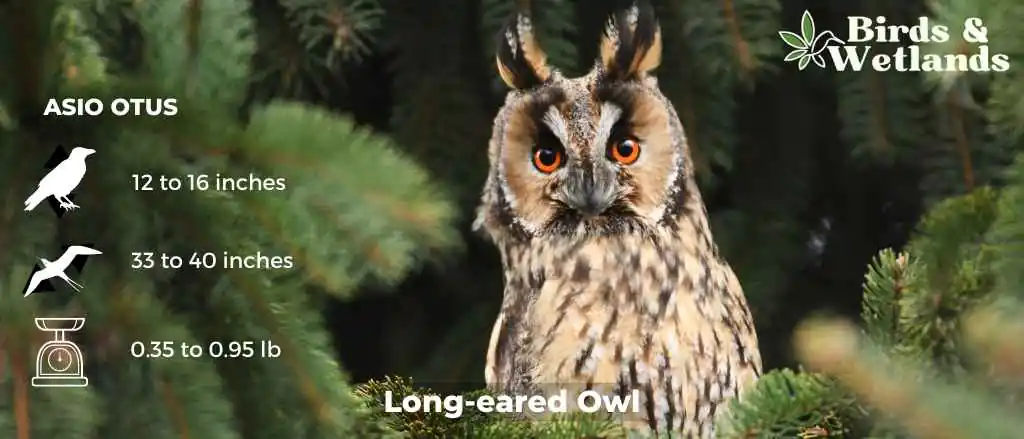

Long-eared Owl Sound
Scientific Name: Asio otus
Length: 12 and 16 in
Wingspan: 2 ft 10 in to 3 ft 4 in
Weight: 5.6 to 15.3 oz
The Long-eared Owl is a medium-sized owl species known for its distinctively long ear tufts, which can be raised or lowered depending on the bird’s mood or intention.
Long-eared Owls have mottled brown and cream plumage, which provides excellent camouflage among the trees. Their most distinctive features are their long, black-tipped ear tufts, which are set closer to the center of the head than in most other owl species.
These owls inhabit a wide variety of habitats, including deciduous and coniferous forests, woodlands, and even semi-deserts.
The Long-eared Owl’s diet primarily consists of small mammals, especially voles, but they will also take small birds and insects. They are skillful hunters, often capturing prey from a perch or in flight.
In terms of nesting behavior, Long-eared Owls do not construct their own nests, instead they take over old nests built by other bird species, usually those of corvids or other large birds. They lay an average of 4 to 5 eggs, which are incubated by the female while the male provides food.
Short-eared Owl (Asio flammeus)
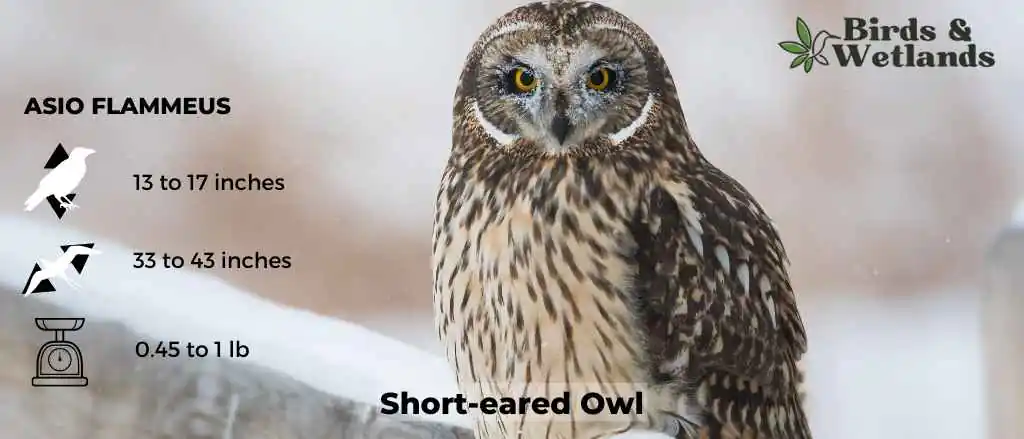
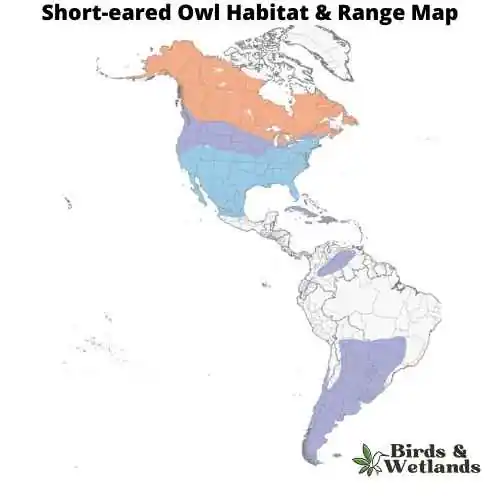
Short-eared Owl Sound
Scientific Name: Asio flammeus
Length: 13–17 in
Wingspan: 33 to 43 in
Weight: 7.3–16.8 oz
The Short-eared Owl is a medium-sized owl species with a wide distribution, found across North and South America, Europe, Asia, and many Pacific islands. Despite its name, the “ears” of the Short-eared Owl are not often visible, as they are small and tend to blend with the bird’s feathers.
The owls are predominantly brown with buff and white accents throughout their body and wings, and dark patches around their yellow eyes.
Short-eared Owls diet consists largely of small mammals, especially voles. However, they are opportunistic hunters and will also prey on a variety of other animals, including other birds, when available.
Their habitat is characterized by open areas like grasslands, marshes, and tundra. They nest on the ground, which is unusual for owls, and this makes them vulnerable to ground predators. As such, they often live in areas with tall grasses or other ground cover for protection.
Northern Pygmy-Owl (Glaucidium gnoma)


Northern Pygmy-Owl Sound
Scientific Name: Glaucidium gnoma
Length: 7 – 7 1/2 in)
Wingspan: 14.5 – 16 in
Weight: 62-73g
The Northern Pygmy-Owl is a small owl species native to North and Central America. Despite its small size, this owl is a fierce predator, known for its distinctive call and daytime hunting habits.
They have a rounded head without ear tufts and large yellow eyes. Their overall coloration is gray or brown with a pattern of white spots on the back and streaks on the front.
Northern Pygmy-Owls inhabit a range of habitats, including coniferous forests, deciduous woodlands, and mixed forests. They can be found at a range of elevations from lowlands to mountains. Unlike many other owl species, they are often active during the day, particularly in the early morning and late afternoon.
Their diet primarily consists of small mammals and birds, but they are also known to eat insects and reptiles. Despite their small size, they have been known to take prey up to three times their own size.
Northern Pygmy-Owls nest in tree cavities, often those created by woodpeckers. They do not build nests of their own but will add a few feathers to the cavity. Clutch size is usually around 2 to 7 eggs, which are incubated by the female while the male brings food.
Boreal Owl (Aegolius funereus)
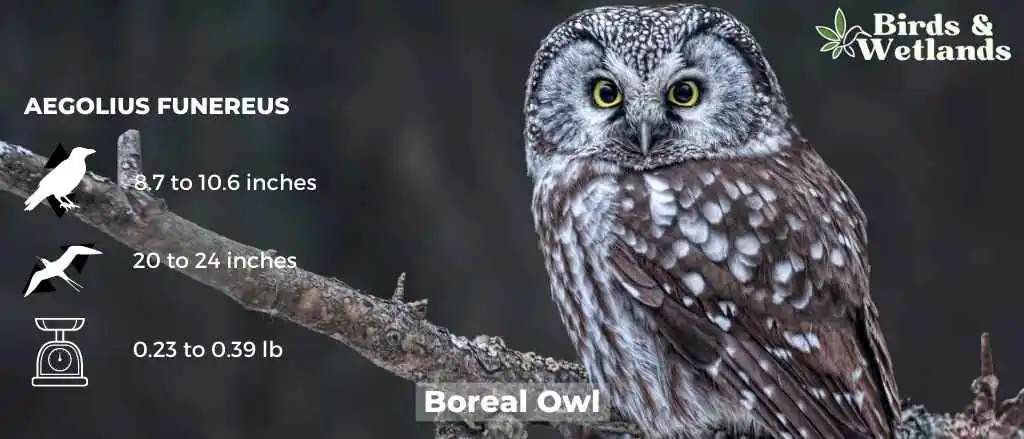
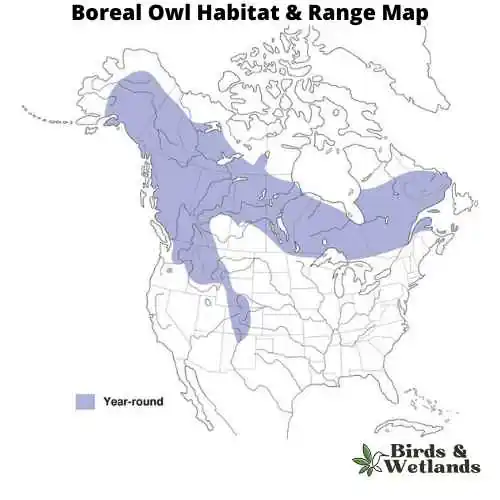
Boreal Owl Sound
Scientific Name: Aegolius funereus
Length: 8.7–10.6 in
Wingspan: 20–24 in
Weight: 3.8 oz–6.3 oz
The Boreal Owl, also known as Tengmalm’s Owl, is a small yet captivating nocturnal bird found predominantly in the northern hemisphere’s boreal forests, hence its name.
The Boreal Owl is petite in size, its plumage is predominantly grayish-brown, with white spots sprinkled on the upper parts and pale streaks on the underside, which lends a mottled effect. The bird’s rounded head, lack of ear tufts, and large yellow eyes are characteristic traits of this species.
Boreal Owls have a distinctive call, described as a series of soft, low hoots, which can often be heard during the cold winter months. As strictly nocturnal birds, they rest during the day, usually in tree cavities or similar concealed spots, and become active at night.
These owls are remarkable hunters, feeding mainly on small mammals such as voles and shrews, although they have been known to consume small birds when available. Their exceptional hearing allows them to locate prey under the snow in the darkest of nights.
The Spotted Owl (Strix occidentalis)
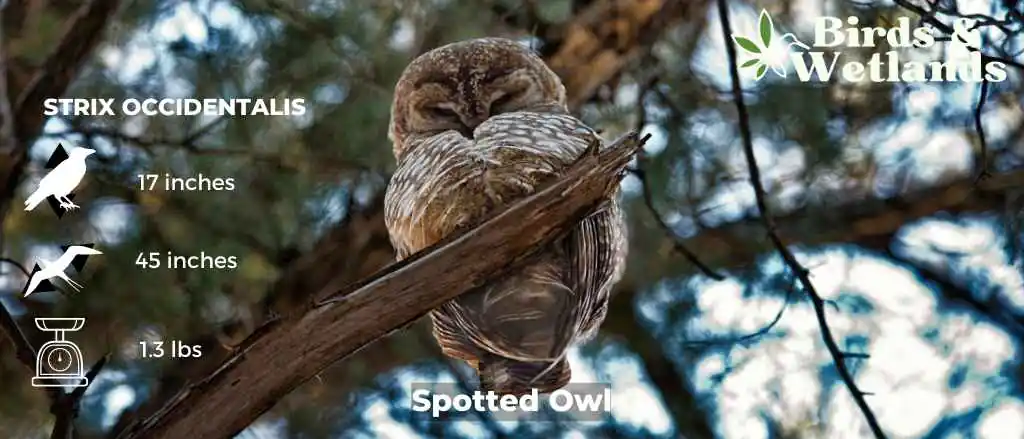

Scientific Name: Strix occidentalis
Length: 17in
Wingspan: 45 in
Weight: 1.3 lb
Spotted owls have a large head and eyes, with a small beak. Their feathers are light brown in color, with white spots on their wing feathers, and dark bars on their tail feathers. They have white spots on their upper body and wings. It has large yellow eyes and a yellow beak.
Its habitat is usually dense coniferous forests. It can be found in old-growth forests of the Pacific Northwest, where it often nests in trees at least 40 feet high.
The spotted owl feeds on small mammals such as rodents and squirrels as well as birds like quail and grouse. It hunts at night when most other animals are sleeping so that it doesn’t get caught by predators like hawks or snakes which also hunt at night time.
Spotted Owls usually nest in tree cavities created by woodpeckers or other birds who eat holes in trees where they make their nests too! The female lays three eggs at a time and both parents take turns sitting on them while they’re incubating (hatching). Once they hatch out, the parents take turns feeding them until they are old enough to hunt for themselves.
Elf Owl
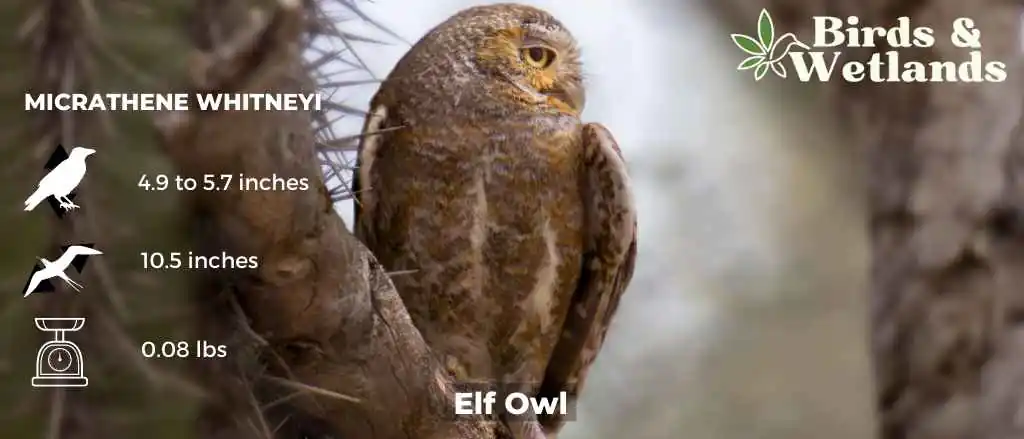
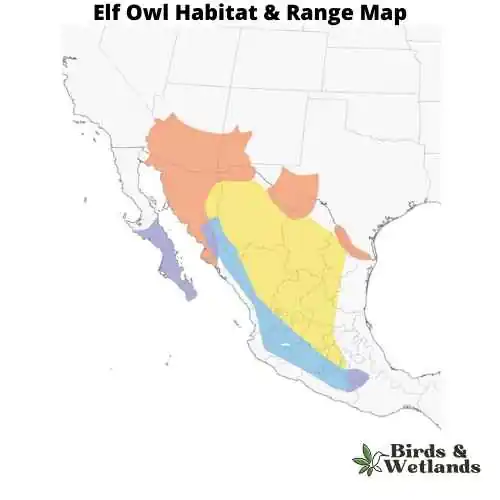
Elf Owl Sound
Scientific Name: Micrathene whitneyi
Length: 4.9 to 5.7 in
Wingspan: 10.5 in
Weight: 1.4 oz
The Elf Owl is a small species of owl that inhabits the southwestern regions of the United States and Mexico. It holds the distinction of being one of the smallest owl species in the world.
Elf Owls are tiny, they have a round head with no ear tufts, large yellow eyes, and a pale gray-brown body with a lightly spotted or streaked pattern.
The primary habitat for Elf Owls includes desert and woodland areas. They are especially fond of regions with saguaro cacti or other types of cavities in trees, which they use for nesting. They are nocturnal creatures, with most of their activity occurring after dusk.
Elf Owls feed primarily on a diet of insects and other small invertebrates. Occasionally, they may also eat small mammals and birds. They are known for their agile flight and keen hunting skills, often catching insects in midair.
When it comes to nesting, Elf Owls take advantage of the natural cavities in trees or cacti, where they lay a clutch of 2 to 4 eggs. The female is responsible for incubation, which lasts about three weeks, while the male provides food.
Flammulated Owl (Psiloscops flammeolus)
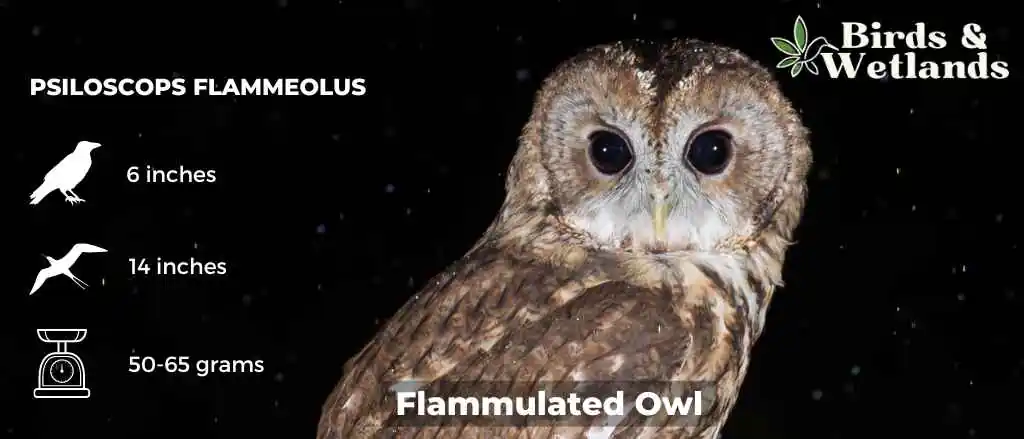
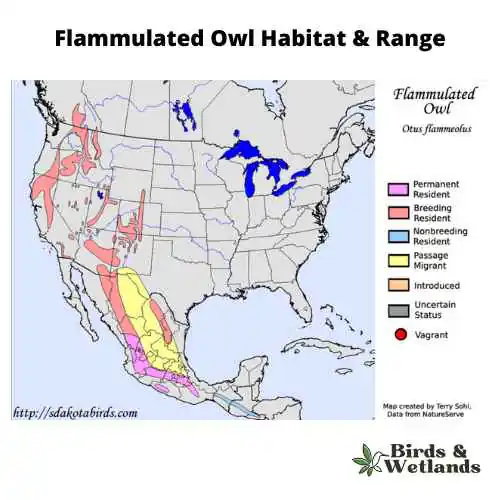
Flammulated Owl Sound
Scientific Name: Psiloscops flammeolus
Length: 6 in
Wingspan: 14 in
Weight: 1.8 – 2.3 oz
The Flammulated Owl is a small owl species native to North America, notable for its incredible migratory journeys, which may span thousands of miles.
Flammulated Owls name “flammulated” comes from the Latin word for flame, and it refers to their flame-like markings. These owls sport a mottled gray and rust color, with dark eye patches and a white throat. Their small size and cryptic plumage help them to blend into the bark of the trees in which they reside.
One of the defining traits of the Flammulated Owl is their diet they predominantly eat insects, particularly moths and beetles.
These owls prefer to nest in mature forests, often in old woodpecker holes or natural tree cavities. They typically lay 2-4 eggs, with the female incubating them for about three weeks, while the male provides food.
Flammulated Owls are known for their soft, low hooting call which can be difficult to hear. This, along with their excellent camouflage, often makes them challenging to spot, despite their widespread distribution.
Whiskered Screech-Owl (Megascops trichopsis)
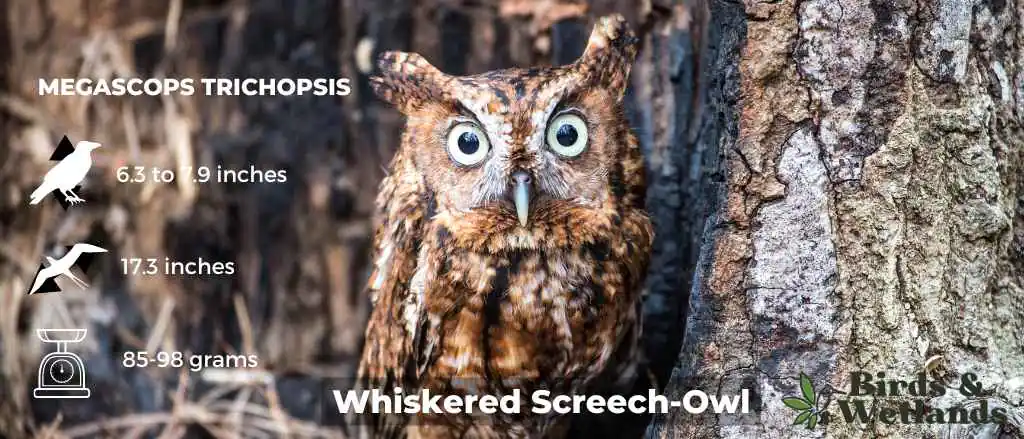
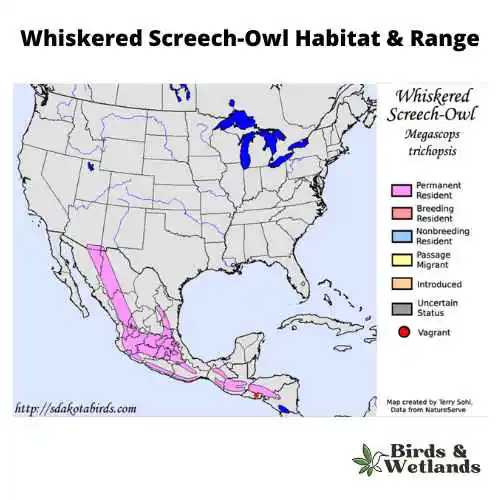
Whiskered Screech-Owl Sound
Scientific Name: Megascops trichopsis
Length: 6.3 to 7.9 in
Wingspan: 17.3 in
Weight: 85 – 98 g
The Whiskered Screech-Owl is predominantly found in pine-oak and evergreen forests in Mexico and the southwestern United States.
The Whiskered Screech-Owl presents a fascinating blend of colours; a rufous or grey hue dominates its plumage, accompanied by streaks and patterns of white on its underparts. One of the most distinctive features of this owl is the presence of “whisker” like feather tufts around its beak, which gives the species its name.
Whiskered Screech-Owls diet is primarily insectivorous, feeding on a variety of insects and spiders, but it’s also known to consume small mammals, birds, and reptiles when available.
Whiskered Screech-Owls are cavity nesters, often occupying tree holes left by woodpeckers or naturally occurring cavities in trees. They lay a clutch of 2 to 4 eggs, which are incubated by the female for about a month.
Ferruginous Pygmy-Owl (Glaucidium brasilianum)

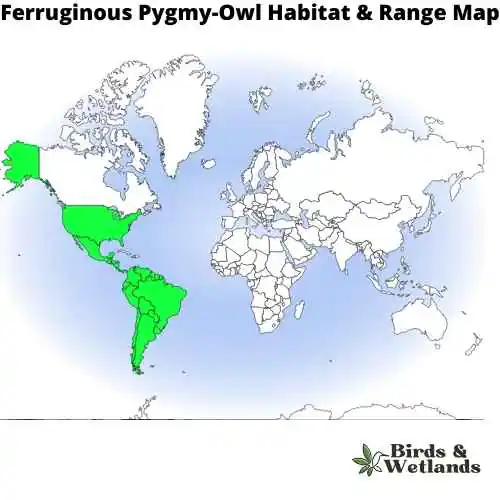
Ferruginous Pygmy-Owl Sound
Scientific Name: Glaucidium brasilianum
Length: 6.50 to 7.09 in
Wingspan: 14.57 to 16.14 in
Weight: 2.20 to 2.70 oz
The Ferruginous Pygmy-Owl boasts a rather distinct colouration, with its back, wings, and head exhibiting a brown to rusty hue — a characteristic that lends the bird its ‘ferruginous’, or iron-rust, name. Contrasting this, its belly is often streaked or spotted with white. The owl’s head features yellow eyes surrounded by bold, white eyebrows, creating a striking expression. The back of the owl’s head is marked with two black patches, often mistaken for eyes by predators or prey.
Ferruginous Pygmy-Owls are versatile predators, feeding on a variety of prey including insects, spiders, and small mammals. They are also known to take birds, reptiles, and amphibians.
Nest-wise, these owls often occupy old woodpecker holes or natural tree cavities, laying a clutch of 3 to 5 eggs. After hatching, the fledglings remain in the nest for about a month, but the parents continue to feed and care for them until they are ready to live independently.
The Ferruginous Pygmy-Owl’s distinctive call is a series of soft, rhythmic toots, which can be heard at all hours of the day or night, often serving as a signal of the owl’s presence in its habitat.
Northern Hawk Owl (Surnia ulula)
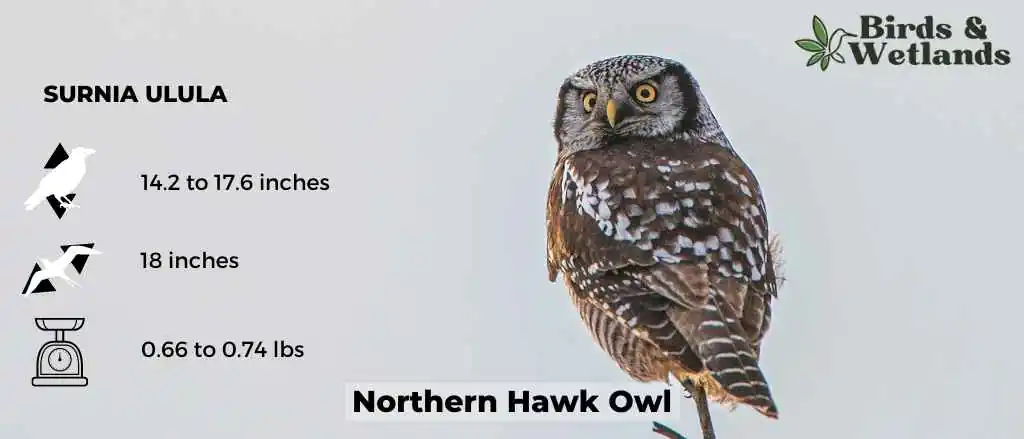
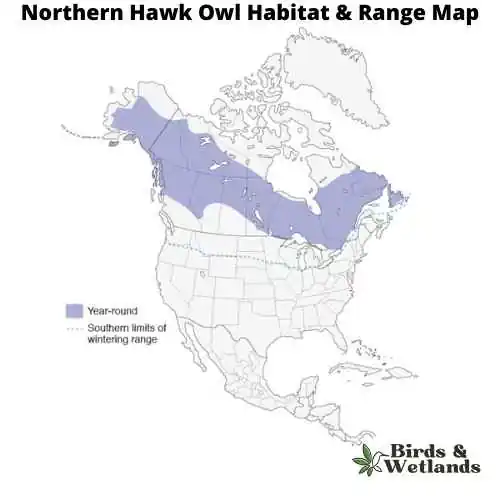
Northern Hawk Owl Sound
Scientific Name:Surnia ulula
Length: 14.2–17.6 in
Wingspan: 18 in
Weight: 11 oz-12 oz
The Northern Hawk Owl, is a medium-sized owl known for its daytime hunting habits and hawk-like behavior, hence its name.
Northern Hawk Owls are recognized by their elongated body, long tail, and lack of ear tufts – traits reminiscent of a hawk. Its plumage is generally dark brown, with white spots on the upper parts and streaks on the underparts. The owl’s face is marked by a white facial disc and distinctive black borders that make it appear somewhat masked.
Diet: consists of small mammals, such as voles, lemmings, and squirrels, but it has also been known to feed on smaller birds. The bird has an extraordinary vision that allows it to spot prey from up to 800 meters away, and it often hunts from a high perch, swooping down on its prey similar to a hawk.
Nesting typically occurs in tree cavities or abandoned nests of other birds. The female Northern Hawk Owl lays between 3 to 11 eggs and is responsible for incubation, while the male provides food and protection.
Other well known owls but not native to the US include the eurasian eagle owl, the eurasian pygmy owl, the tawny owl, polar owl and the striped owl.
Owl Watching Tips
Owl watching, or “owling,” can be a rewarding experience, bringing one closer to these magnificent and elusive creatures. Here are some tips for those keen on observing owls in their natural habitats:
Research and understand the owl species in your area, their habitats, and habits. Some owls are more active at dusk and dawn, known as being crepuscular, while others are strictly nocturnal.
Use a good field guide and familiarise yourself with owl calls, which can often be more helpful in locating owls than trying to see them. Numerous apps and websites offer recordings of owl calls.
Bring binoculars for clear viewing and a flashlight with a red filter, which is less likely to disturb the owls.
Finally, respect the owls and their environment. Keep a respectful distance, do not disturb them or their habitats, and remember that their well-being is more important than a photo or close-up view.

